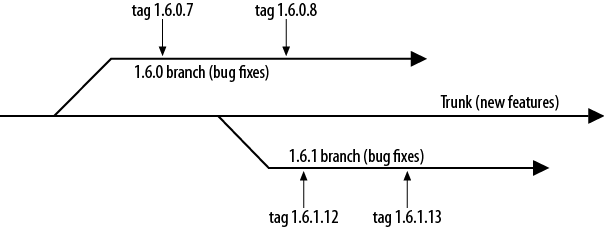The Asterisk release methodology has gone through a couple of iterations over the last few years, and this section is designed to help you understand what the version numbers mean. Of particular relevance is the change in versioning that happened with the 1.6.x series of releases, which followed a different numbering logic than all other Asterisk releases (1.0 to 1.8 and onward for the foreseeable future).
When we had just Asterisk 1.2 and 1.4, all new development was carried out in trunk (it still is), and only bug fixes went into the 1.2 and 1.4 branches. The Asterisk 1.2 branch has been marked as EOL (End of Life), and is no longer receiving bug fixes or security updates. Prior to the 1.6.x branches, bug fixes were carried out only in trunk and in the 1.4 branch.
Because all new development was done in trunk, until the 1.6 branch was created people were unable to get access to the new features and functionality. This isn’t to say the new functionality wasn’t available, but with all the changes that can happen in trunk, running a production server based on it requires a very Asterisk-savvy (and C code–savvy) administrator.
To try to relieve the pressure on administrators, and to enable faster access to new features (in the time frame of months, and not years), a new methodology was created. Branches in 1.6 would actually be marked as 1.6.0, 1.6.1, 1.6.2, etc., with the third number increasing by one each time a new feature release was created. The goal was to provide new feature releases every 3–4 months (which would be branched from trunk), providing a shorter and clearer upgrade path for administrators. If you needed a new feature, you’d only have to wait a few months and could then upgrade to the next branch.
Tags from these branches look like this:
Figure 2.2, “The Asterisk 1.6.x release process” gives a visual representation of the branching and tagging process in relation to Asterisk trunk.
So, so far we have branches, which are 1.2, 1.4, 1.6.0, 1.6.1, and 1.6.2 (there is no 1.6 branch). Within each of those branches, we create tags (releases), which look like 1.2.14, 1.4.30, 1.6.0.12, 1.6.1.12, and 1.6.2.15.
Unfortunately, it ended up not working out that 1.6.x branches were created from trunk every 3–4 months: the development process has led to a minimum release time of 6–8 months. Not only that, but the 1.6.x numbering methodology adds problems of its own. People got confused as to what version to run, and that the 1.6.0, 1.6.1, and 1.6.2 branches were all separate major version upgrades. When you increase the number from 1.2 to 1.4, and then to 1.8, it is obvious that those are distinct branches and major version changes. With 1.6.0, 1.6.1, and 1.6.2, it is less obvious.
The development team learned a lot of things during the 1.6.x releases. The idea surrounding the releases was noble, but the implementation ended up being flawed when put into real use. So, with Asterisk 1.8, the methodology has changed again, and will look a lot more like that used in the 1.2 and 1.4 releases.
While the development team still wants to provide access to new features and core changes on a more regular basis (every 12 months being the goal), there is recognition that it is also good to provide long-term support to a stable, popular version of Asterisk. You can think of the Asterisk 1.4 branch as being a long-term support (LTS) version. The 1.6.0, 1.6.1, and 1.6.2 branches can be thought of as feature releases that continue to receive bug fixes after release, but are supported for a shorter period of time (about a year). The new LTS version is Asterisk 1.8 (what this book is based on); it will receive bug fixes for four years and an additional year of security releases after that, providing five years of support from the Digium development team.
During the long-term support phase of Asterisk 1.8, additional branches will be created on a semi-regular basis as feature releases. These will be tagged as versions 1.10, 1.12, and 1.14, respectively. Each of these branches will receive bug fixes for a period of one year, and security releases will continue to be made for an additional year before the branches are marked as EOL.
The current statuses of all Asterisk branches, their release dates, when they will go into security release–only mode, and when they will reach EOL status are all documented on the Asterisk wiki at https://wiki.asterisk.org/wiki/display/AST/Asterisk+Versions.
